CHAPTER XIX, Part TWO.
Yonkers is the name of a large and rapidly-growing village about four miles below Hastings, and seventeen from New York. Its recent growth and prosperity are almost wholly due to the Hudson River Railway, which furnishes such traveling facilities and accommodations, that hundreds of business men in the city of New York have chosen it for their summer residences, and many of them for their permanent dwelling-places. Like Sing-Sing, Tarrytown, Irvington, and Dobbs's Ferry, it has a hilly and exceedingly picturesque country around; and through it the dashing Neperah, or Saw-Mill River, after flowing many miles among the Greenburgh hills, finds its way into the Hudson in a series of rapids and cascades. It forms a merry feature in the scenery of the village.
Yonkers derives its name from Yonkheer--Young Master or Lord--the common appellation for the heir of a Dutch family. It is an old settlement, lands having been purchased here from the sachems by some of the Dutch West India Company as early as the beginning of Peter Stuyvesant's administration of the affairs of New Netherland.* Here was the Indian village of Nap-pe-cha-mak, a name signifying "the rapid water settlement." This was the name of the stream, afterwards corrupted to Neperah, and changed by the Dutch and English to Saw-Mill River. Those utilitarian fathers have much to answer for, because they expelled from our geographical vocabulary so many of the beautiful and significant Indian names.
* The domain included in the towns of Yonkers, West Farms, and Morrisania was purchased of the Indians by Adriaen Van Der Donck, the "first lawyer in New Netherland," and confirmed to him in 1646 by grant from the Dutch West India Company, with the title and privilege of Patroon. It contained 24,000 acres. He called it Colen Donck or donck's Colony. Van der Donck, who died in 1655, was an active man in New Amsterdam (now New York), and took part with the people against the governor when disputes arose. He wrote an interesting description of the country. After the English conquest of New Netherland, Frederick Philipse and others purchased a greater portion of his estate on the Hudson and Harlem rivers.
To the resident, the visitor, and the tourist, the scenery about Yonkers is most attractive; and the delightful roads in all directions invite equestrian and carriage excursionists to real pleasure. Those fond of boating and bathing, fishing and fowling, may here find gratification at proper seasons, within a half-hour's ride, by railway, from the metropolis.
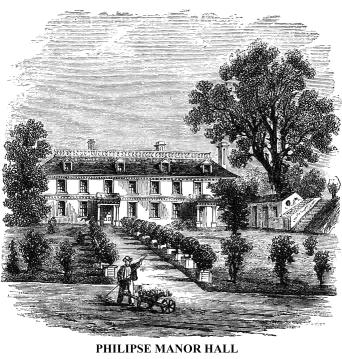 The
chief attraction at Yonkers for the antiquary is the Philipse Manor Hall,
a spacious stone edifice, that once belonged to the lords of Philipse Manor.
The older portion was built in 1682. The present front, forming an addition,
was erected in 1745, when old "Castle Philipse," at Sleepy Hollow,
was abandoned, and the Manor Hall became the favourite dwelling of the family.
Its interior construction (preserved by the present owner, the Hon. W.W. Woodworth,
with scrupulous care) attests the wealth and taste of the lordly proprietor.
The great Hall, or passage, is broad, and the staircase capacious and massive.
The rooms are large, and the ceilings are lofty; all the rooms are wainscoted,
and the chief apartment has beautiful ornamental work upon the ceiling, in
high relief, composed of arabesque forms, the figures of birds, dogs, and
men, and two medallion portraits. Two of the rooms have carved chimney-pieces
of grey Irish marble. The guest-chamber, over the drawing-room, is handsomely
decorated with ornamental architecture, and some of the fire-places are surrounded
with borders of ancient Dutch tiles. The well has a subterranean passage leading
from it, nobody knows to where; and the present ice-house, seen on the right
of the picture, composed of huge walls and massive arch, was a powder-magazine
in the "olden time." Altogether, this old hall--one of the antiquities
of the Hudson--is an attractive curiosity, which the obliging proprietor is
pleased to show to those who visit it because of their reverence for things
of the past. It possesses a bit of romance, too; for here was born, and here
lived, Mary Philipse, whose charms captivated the heart of young Washington,
but whose hand was given to another, as we shall observe hereafter.
The
chief attraction at Yonkers for the antiquary is the Philipse Manor Hall,
a spacious stone edifice, that once belonged to the lords of Philipse Manor.
The older portion was built in 1682. The present front, forming an addition,
was erected in 1745, when old "Castle Philipse," at Sleepy Hollow,
was abandoned, and the Manor Hall became the favourite dwelling of the family.
Its interior construction (preserved by the present owner, the Hon. W.W. Woodworth,
with scrupulous care) attests the wealth and taste of the lordly proprietor.
The great Hall, or passage, is broad, and the staircase capacious and massive.
The rooms are large, and the ceilings are lofty; all the rooms are wainscoted,
and the chief apartment has beautiful ornamental work upon the ceiling, in
high relief, composed of arabesque forms, the figures of birds, dogs, and
men, and two medallion portraits. Two of the rooms have carved chimney-pieces
of grey Irish marble. The guest-chamber, over the drawing-room, is handsomely
decorated with ornamental architecture, and some of the fire-places are surrounded
with borders of ancient Dutch tiles. The well has a subterranean passage leading
from it, nobody knows to where; and the present ice-house, seen on the right
of the picture, composed of huge walls and massive arch, was a powder-magazine
in the "olden time." Altogether, this old hall--one of the antiquities
of the Hudson--is an attractive curiosity, which the obliging proprietor is
pleased to show to those who visit it because of their reverence for things
of the past. It possesses a bit of romance, too; for here was born, and here
lived, Mary Philipse, whose charms captivated the heart of young Washington,
but whose hand was given to another, as we shall observe hereafter.
In the river, in front of Yonkers, the Half-Moon, Henry Hudson's
exploring vessel, made her 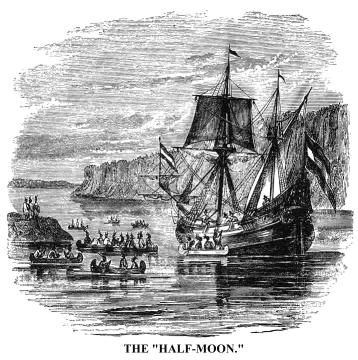 second
anchorage after leaving New York Bay. It was toward the evening of the 12th
of September, 1609; the explorer had then been several days in the vicinity
of Man-na-hat-ta, as the Indians called the island on which New York stands,
and had had some intercourse with the natives. "The twelfth," says
"Master Ivet (Juct) of the Lime House," who wrote Hudson's journal,
"faire and hot. In the afternoon, at two of the clocke, wee weighed,
the winde being variable, betweene the north and the north-west. So we turned
into the Riuer two leagues, and anchored. This morning, at ovr first rode
in the Riuer, there came eight-and-twentie Canoes full of men, women, and
children, to betray vs; but we saw their intent, and suffered none of them
to come abord of vs. At twelve of the clocke they departed; they brought with
them Oysters and Beanes, whereof wee bought some. They have great tobacco-pipes
of Yellow Copper, and Pots of Earth to dresse their meate in." That night
a strong tidal current placed the stern of the Half-Moon up stream. That event,
and the assurance of the natives that the waters northward, upon which he
had gazed with wonder and delight, came from far beyond the mountains, inspired
Hudson with great hope, for it must be remembered that his errand was the
discovery of a northern passage to India. He now doubted not that the great
river upon which he was floating flowed from ocean to ocean, and that his
search was nearly over, and would be speedily crowned with success.
second
anchorage after leaving New York Bay. It was toward the evening of the 12th
of September, 1609; the explorer had then been several days in the vicinity
of Man-na-hat-ta, as the Indians called the island on which New York stands,
and had had some intercourse with the natives. "The twelfth," says
"Master Ivet (Juct) of the Lime House," who wrote Hudson's journal,
"faire and hot. In the afternoon, at two of the clocke, wee weighed,
the winde being variable, betweene the north and the north-west. So we turned
into the Riuer two leagues, and anchored. This morning, at ovr first rode
in the Riuer, there came eight-and-twentie Canoes full of men, women, and
children, to betray vs; but we saw their intent, and suffered none of them
to come abord of vs. At twelve of the clocke they departed; they brought with
them Oysters and Beanes, whereof wee bought some. They have great tobacco-pipes
of Yellow Copper, and Pots of Earth to dresse their meate in." That night
a strong tidal current placed the stern of the Half-Moon up stream. That event,
and the assurance of the natives that the waters northward, upon which he
had gazed with wonder and delight, came from far beyond the mountains, inspired
Hudson with great hope, for it must be remembered that his errand was the
discovery of a northern passage to India. He now doubted not that the great
river upon which he was floating flowed from ocean to ocean, and that his
search was nearly over, and would be speedily crowned with success.
A mile and a half below Yonkers, on the bank of the Hudson, is Font Hill, formerly the residence of Edwin Forrest, the eminent American tragedian. The mansion is built of blue granite, in the English castellated form, a style not wholly in keeping with the scenery around it. It would have been peculiarly appropriate and imposing among the rugged hills of the Highlands thirty or forty miles above. The building has six towers, from which very extensive views of the Hudson and the surrounding country may be obtained. The flag, or stair tower, is seventy-one feet in height.
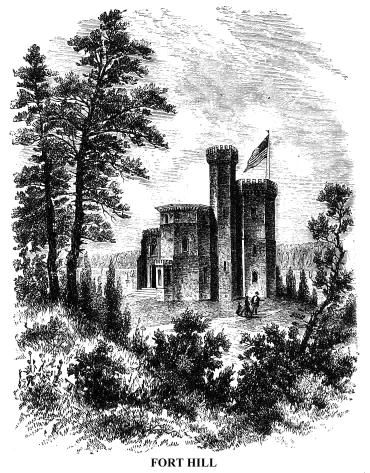 To
this delightful residence Mr. Forrest brought his bride, Miss Catherine Sinclair,
daughter of the celebrated Scotch vocalist, in 1838, and for six years they
enjoyed domestic and professional life in an eminent degree. Unfortunately
for his future peace, Mr. Forrest was induced to visit England in 1844. He
was accompanied by his wife. There he soon became involved in a bitter dispute
with the dramatic critic of the London Examiner, and Macready the actor. This
quarrel led to the most serious results. Out of it were developed the mob
and the bloodshed of what is known, in the social history of the city of New
York, as the "Astor Place Riot," and with it commenced Mr. Forrest's
domestic troubles, which ended, as all the world knows, in the permanent separation
of himself and wife. Font Hill, where he had enjoyed so much happiness, lost
its charms, and he sold it to the Roman Catholic Sisters of Charity, of the
Convent and Academy of Mount St. Vincent. This institution was founded in
1847, and the academy was in 105th Street, between the Fifth and Sixth Avenues,
New York. It is devoted to the instruction of young ladies. The community,
numbering about two hundred Sisters at the time of my visit, was scattered.
Some were at Font Hill, and others were at different places in the city and
neighbourhood. The whole were under the general direction of Mother Superior
Mary Angela Hughes. At Font Hill they erected an extensive and elegant pile
of buildings, of which they took possession, and wherein they opened a school,
on the 1st of
To
this delightful residence Mr. Forrest brought his bride, Miss Catherine Sinclair,
daughter of the celebrated Scotch vocalist, in 1838, and for six years they
enjoyed domestic and professional life in an eminent degree. Unfortunately
for his future peace, Mr. Forrest was induced to visit England in 1844. He
was accompanied by his wife. There he soon became involved in a bitter dispute
with the dramatic critic of the London Examiner, and Macready the actor. This
quarrel led to the most serious results. Out of it were developed the mob
and the bloodshed of what is known, in the social history of the city of New
York, as the "Astor Place Riot," and with it commenced Mr. Forrest's
domestic troubles, which ended, as all the world knows, in the permanent separation
of himself and wife. Font Hill, where he had enjoyed so much happiness, lost
its charms, and he sold it to the Roman Catholic Sisters of Charity, of the
Convent and Academy of Mount St. Vincent. This institution was founded in
1847, and the academy was in 105th Street, between the Fifth and Sixth Avenues,
New York. It is devoted to the instruction of young ladies. The community,
numbering about two hundred Sisters at the time of my visit, was scattered.
Some were at Font Hill, and others were at different places in the city and
neighbourhood. The whole were under the general direction of Mother Superior
Mary Angela Hughes. At Font Hill they erected an extensive and elegant pile
of buildings, of which they took possession, and wherein they opened a school,
on the 1st of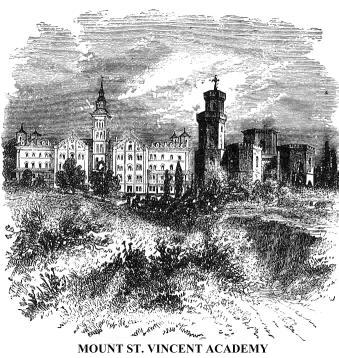 September, 1859. It was much enlarged in 1865. They had, in 1860, about one
hundred and fifty pupils, all boarders, to whom was offered the opportunity
of acquiring a thorough education. The chaplain of the institution occupies
the "castle."
September, 1859. It was much enlarged in 1865. They had, in 1860, about one
hundred and fifty pupils, all boarders, to whom was offered the opportunity
of acquiring a thorough education. The chaplain of the institution occupies
the "castle."
Two miles and a-half below Font Hill, or Mount St. Vincent,
is Spyt den Duyvel Creek, at the head of York or Manhattan Island. This is
a narrow stream, winding through a little tortuous valley for a mile or more,
and connecting, at Kingsbridge, with the Harlem River, the first formed by
the inflowing of the tide waters of the Hudson, and the last by the waters
of the East River. At ebb-tide the currents part at Kingsbridge. The view
from the mouth of the Spyt den Duyvel, over which the Hudson River Railway
passes, looking either across the river to the Palisades, as given in our
sketch, or inland, embracing bold Berrian's Neck on the left, and the wooded
head o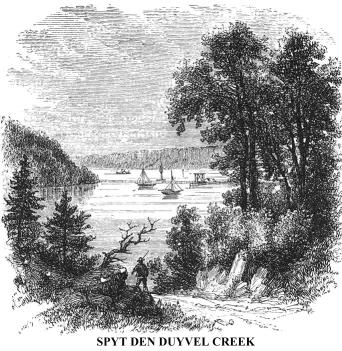 f Manhattan
Island on the right, with the winding creek, the cultivated ridge on the borders
of Harlem River, and the heights of Fordham beyond, present pleasant scenes
for the artist's pencil. To these natural scenes, history and romance lend
the charm of their associations.
f Manhattan
Island on the right, with the winding creek, the cultivated ridge on the borders
of Harlem River, and the heights of Fordham beyond, present pleasant scenes
for the artist's pencil. To these natural scenes, history and romance lend
the charm of their associations.
Here, on the 2nd of October, 1608, Henry Hudson had a severe fight with the Indians, who attacked the Half-Moon with arrows from canoes and the points of land, as she lay at anchor in the sheltering mouth of the creek. Here, too, while Governor Stuyvesant was absent on the Delaware, nine hundred of the river Indians encamped, and menaced the little town of New Amsterdam, at the lower extremity of the island, with destruction. Here, according to Diedrick Knickerbocker's "History of New York," Anthony Van Corlear, the trumpeter of Governor Stuyvesant, lost his life in attempting to swim across the creek during a violent storm. "The wind was high," says the chronicler, "the elements were in an uproar, and no Charon could be found to ferry the adventurous sounder of brass across the water. For a short time he vapoured like an impatient ghost upon the brink, and then bethinking himself of the urgency of his errand (to arouse the people to arms), he took a hearty embrace of his stone bottle, swore most valorously that he would swim across in spite of the devil (en spyt den duyvel), and daringly plunged into the stream. Luckless Anthony! Scarcely had he buffeted half way over, when he was observed to struggle violently, as if battling with the Spirit of the waters. Instinctively he put his trumpet to his mouth, and giving a vehement blast, sank for ever to the bottom! The clangour of his trumpet, like that of the ivory horn of the renowned Paladin Orlando, when expiring in the glorious field of Roncesvalles, rang far and wide through the country, alarming the neighbours round, who hurried in amazement to the spot. Here an old Dutch burgher, famed for his veracity, and who had been a witness of the fact, related to them the melancholy affair; with the fearful addition (to which I am slow in giving belief), that he saw the Duyvel, in the shape of a huge moss-bonker (a species of inferior fish) seize the sturdy Anthony by the leg, and drag him beneath the waves. Certain it is, the place, with the adjoining promontory, which projects into the Hudson, has been called Spyt den Duyvel ever since."
During the war for independence, stirring events occurred in the vicinity of the Spyt den Duyvel Creek. Batteries were erected on promontories on each side of it, at its junction with the Hudson; and in Westchester County, in its immediate neighbourhood, many skirmishes took place between Cow Boys and Skinners, Whigs and Tories, British, Hessians, and Indians.
A picturesque road passes along the foot of the Westchester hills that skirt the Spyt den Duyvel Valley, to the mouth of Tippett's Creek, which comes flowing down from the north through a delightful valley, at the back of Yonkers and the neighbouring settlements. This creek was called Mosh-u-la by the Indians, and the valley was the favourite residence of a warlike Mohegan tribe. Its lower portion was the scene of almost continual skirmishing during a portion of the war for independence.
Tippett's Creek is crossed by a low bridge. A few yards beyond
it is Kingsbridge, at the head of 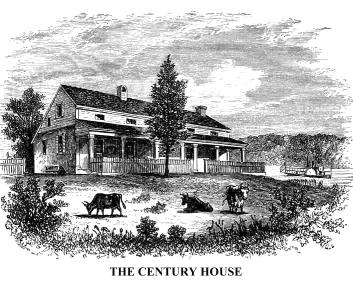 the
Harlem River, which here suddenly expands into lake-like proportions. The
shores on both sides are beautiful, and the view that opens towards Long Island,
beyond the East River, is charming.
the
Harlem River, which here suddenly expands into lake-like proportions. The
shores on both sides are beautiful, and the view that opens towards Long Island,
beyond the East River, is charming.
Kingsbridge has always been a conspicuous point. Land was granted there, in 1693, to Frederick Philipse, with power to erect a toll-bridge, it being specified that it should be called The King's Bridge. This was the only bridge that connected Manhattan Island with the Main, and hence all travelers and troops were compelled to cross it, unless they had boats for ferrying. Here, during the war for independence, hostile forces were frequently confronted; and from its northern end to the Croton river, was the famous "Neutral Ground" during the struggle, whereon neither Whig nor Tory could live in peace or safety. Upon the heights each side of the bridge redoubts were thrown up; and here, in January, 1777, a bloody conflict occurred between the Americans, under General Heath, and a large body of Hessian mercenaries, under General Knyphausen. The place was held alternately by the Americans and British; and little more than half a mile below the bridge an ancient story-and-a-half house is yet standing, one hundred and twenty-five years old, which served as head-quarters at different times for the officers of the two armies: it is now a house of public entertainment, and is known as "Post's Century House."
Copyright © 1998, -- 2004. Berry Enterprises. All rights reserved. All items on the site are copyrighted. While we welcome you to use the information provided on this web site by copying it, or downloading it; this information is copyrighted and not to be reproduced for distribution, sale, or profit.